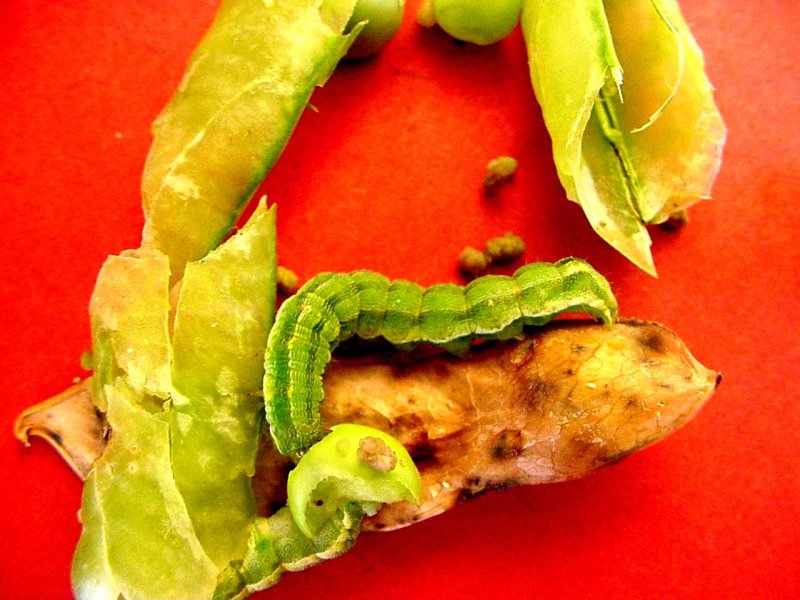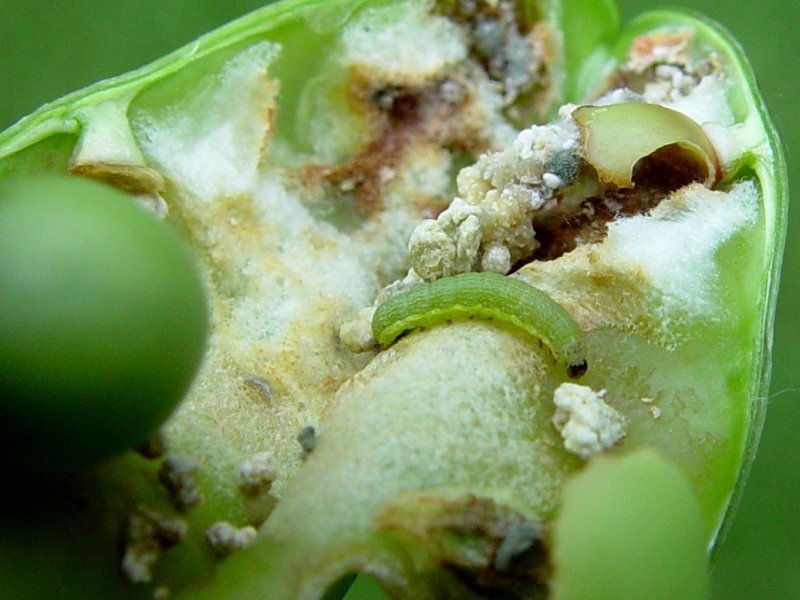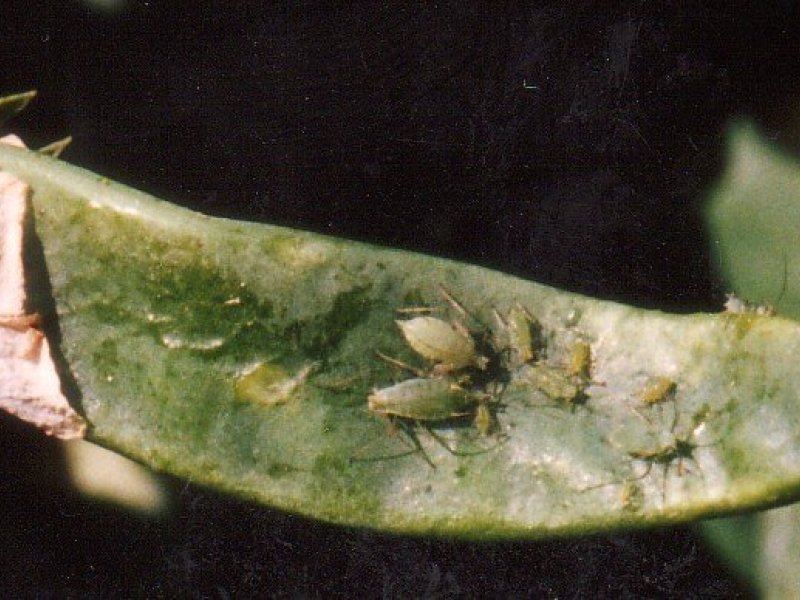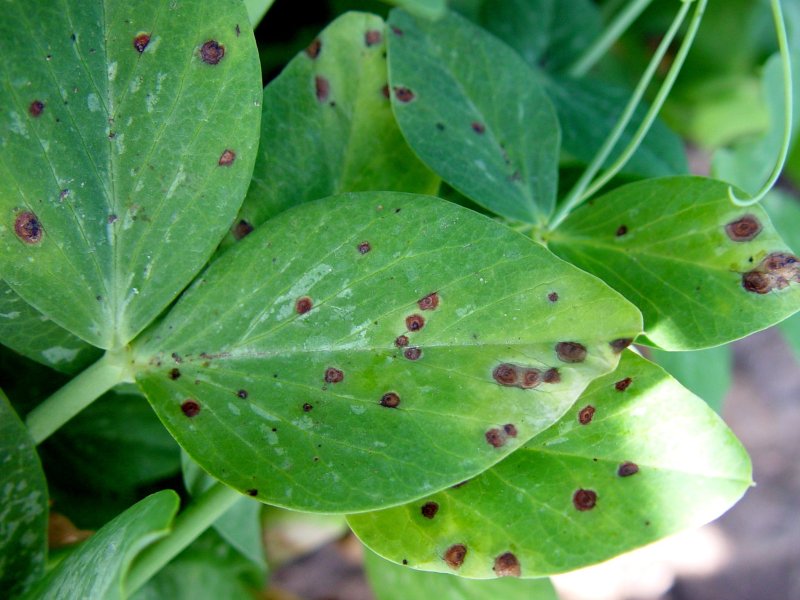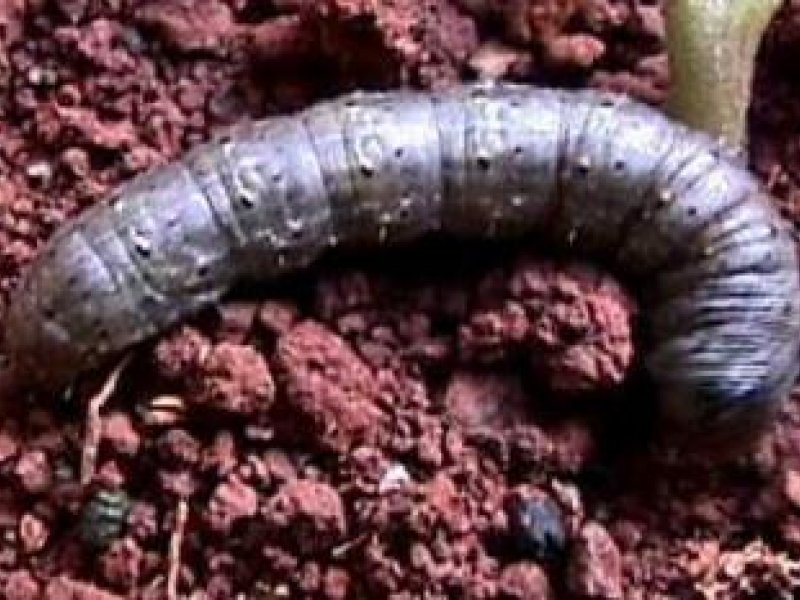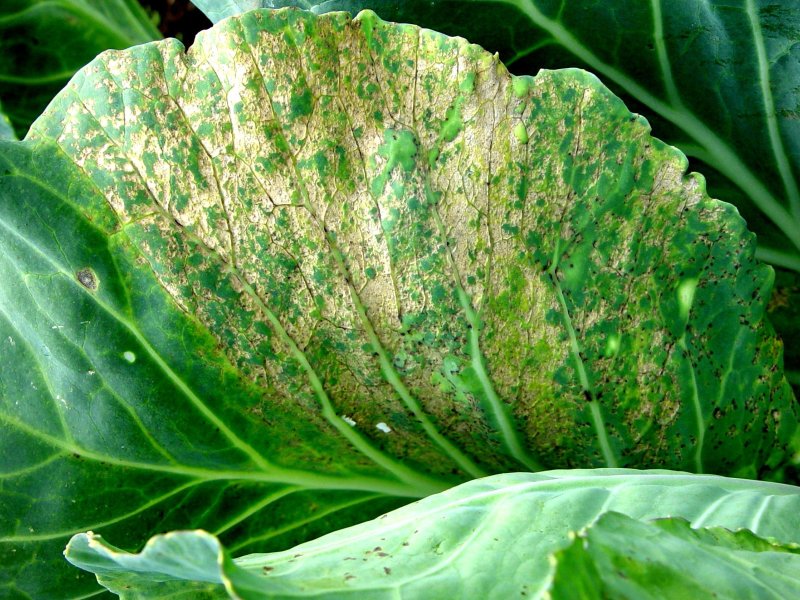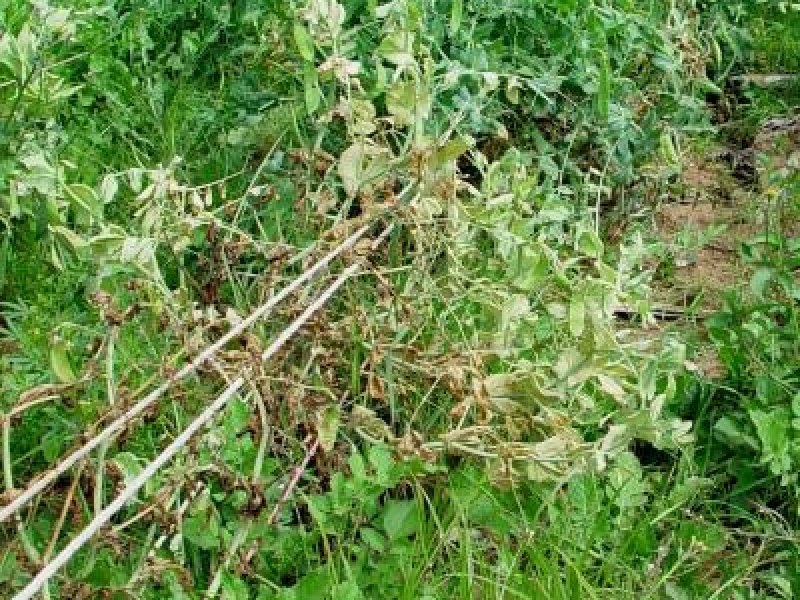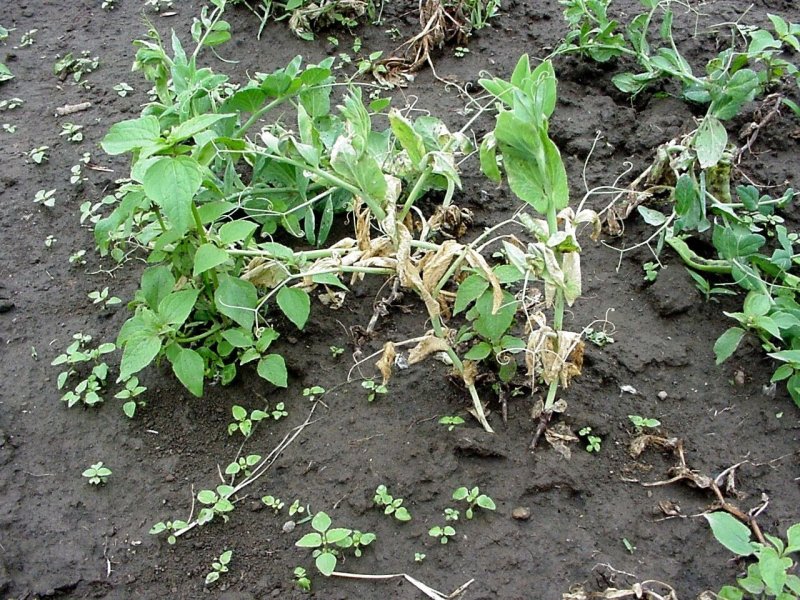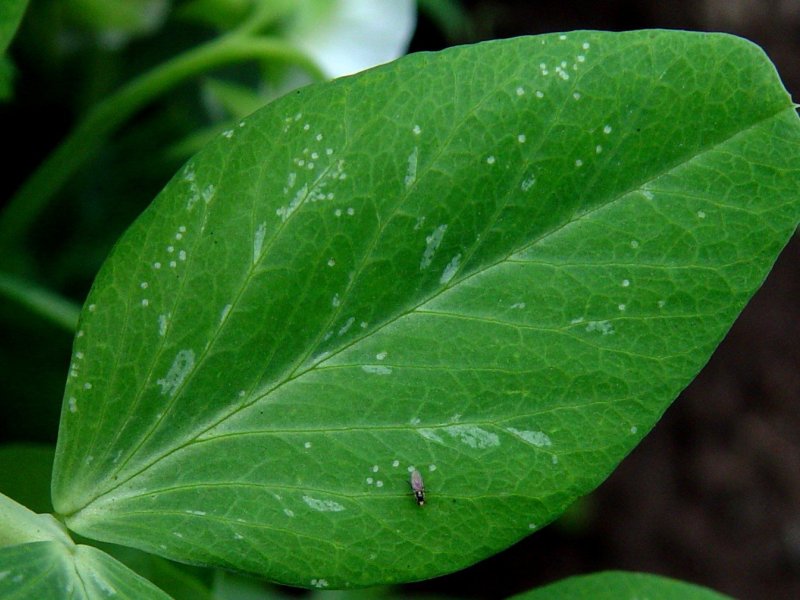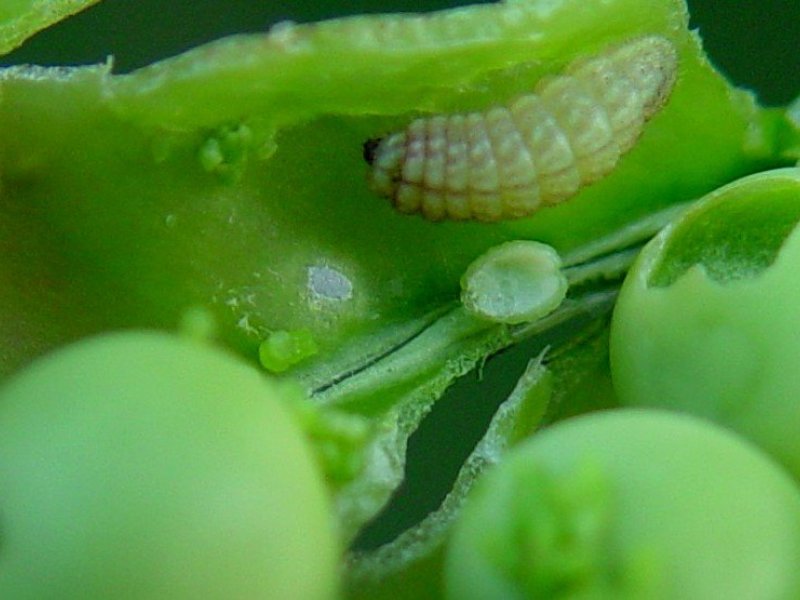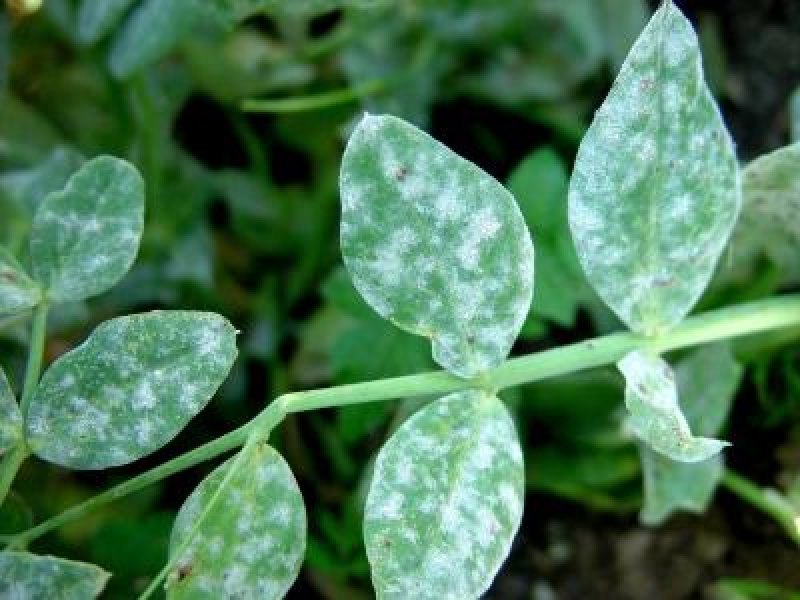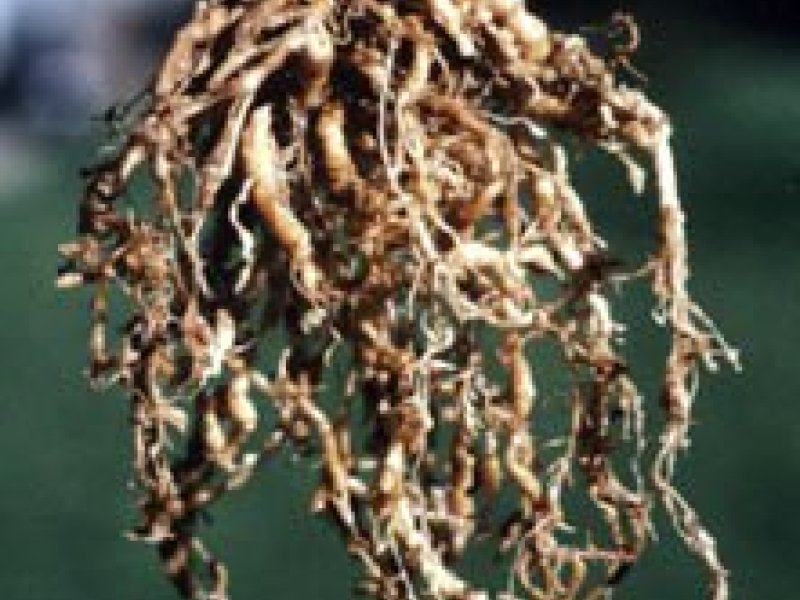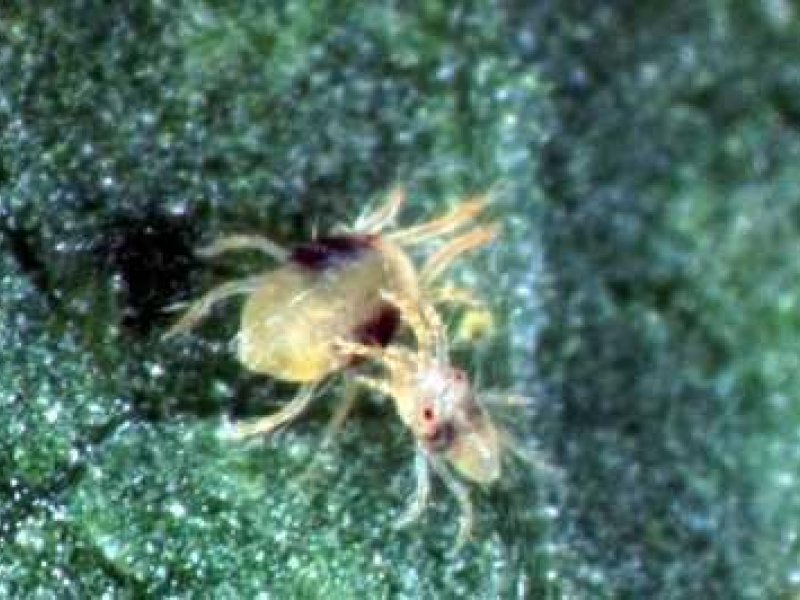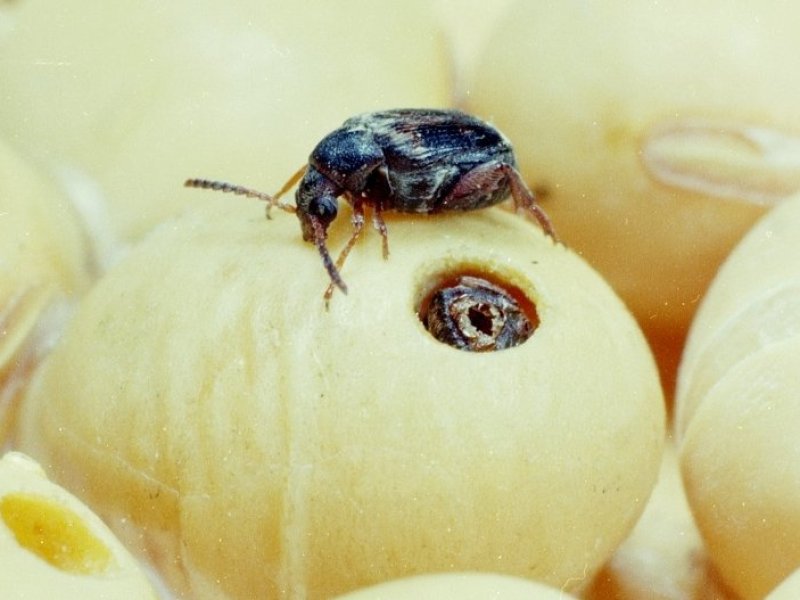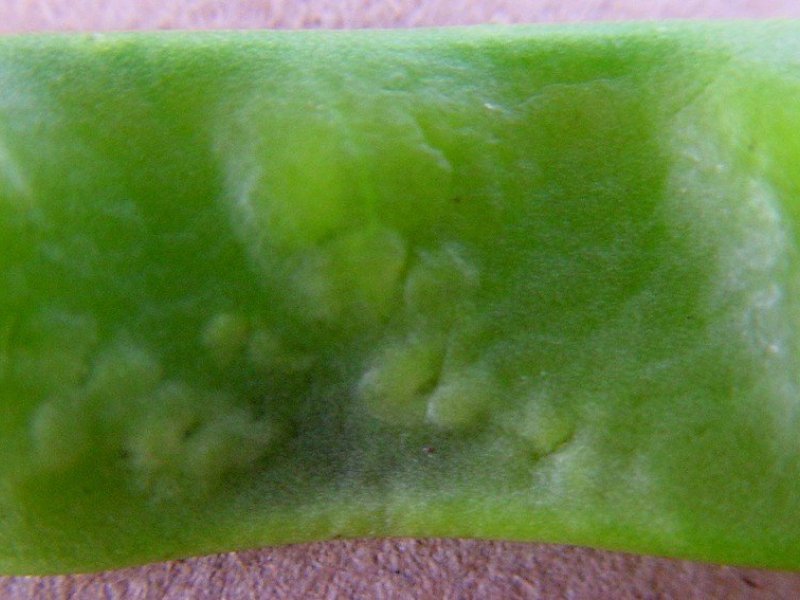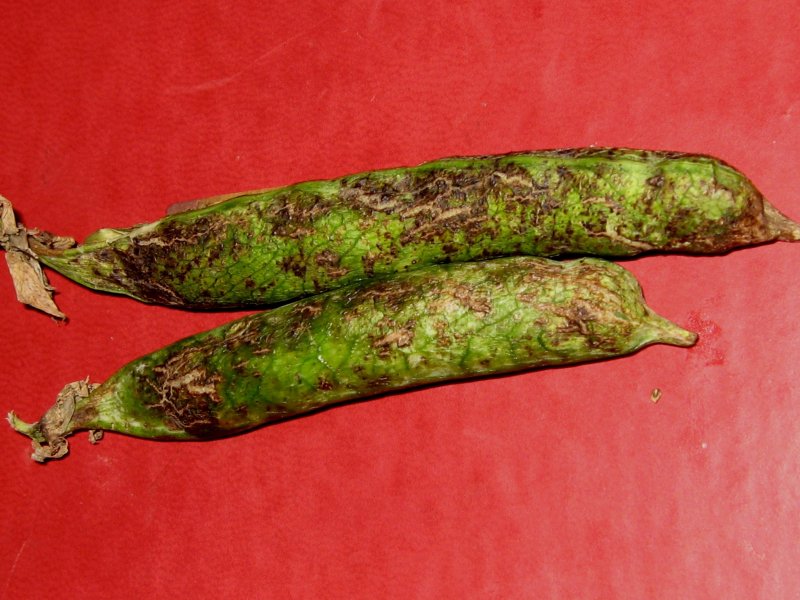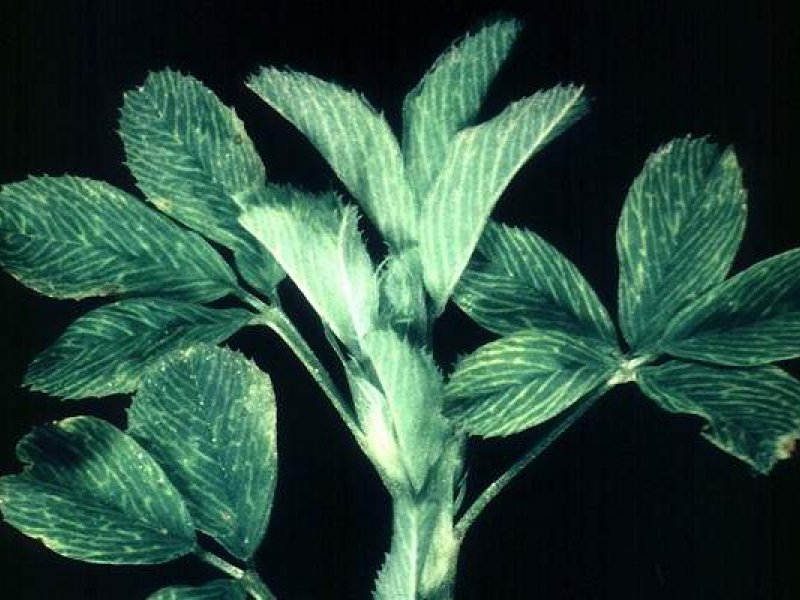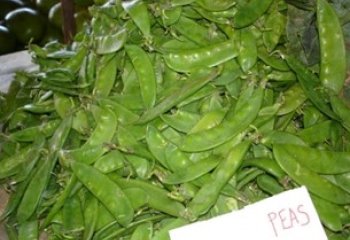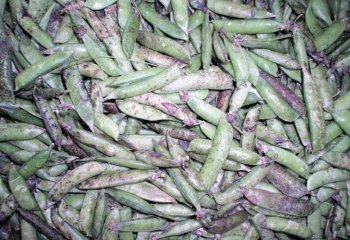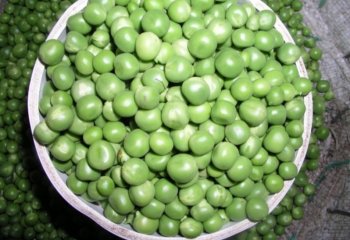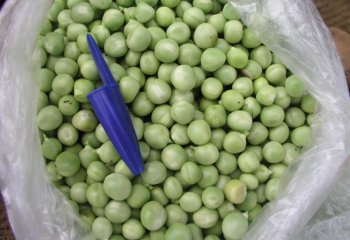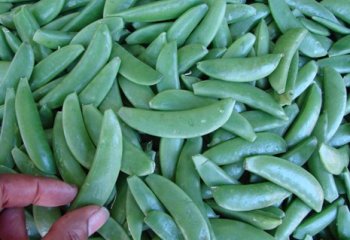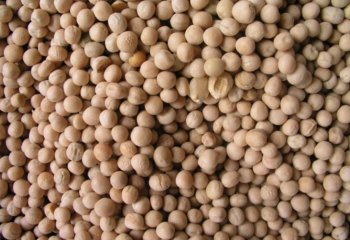|
African bollworm (Helicoverpa armiguera) and other caterpillars Various species of caterpillars feed on leaves and pods of peas. The most common are the African bollworm (Helicoverpa armiguera), the beet armyworm (Spodotera exigua) and hairy caterpillars (Arctiidae).
Caterpillars bore holes and feed on leaves, flower buds and maturing pods eating the seeds. They also attack young pods eating the pod wall and the developing seeds. |
|
|
What to do:
|
|
Aphids Aphids are serious pests of peas. The pea aphid (Acyrthosiphon pisum), the cowpea aphid (Acyrthosiphon pisum), and Myzus sp. (Aphis carccivora), are found on young leaves and growing points.
They suck sap from leaves, stems, blossoms and pods. Feeding by aphids causes leaf distortion and wilting. Heavily infested plants are stunted and produce fewer and smaller pods and seeds. The pea aphid may also transmit viruses such as pea enation mosaic virus, pea streak virus and pea leaf roll virus. Parasitic wasps and predators (hoverflies and ladybird beetles) are important for natural control of aphids. |
|
|
What to do:
|
|
Ascochyta blight (Ascochyta pisi, A. pinodella/Mycosphaerella pinodes) Ascochyta blight attacks all parts of the plant. The infected leaves have small to large, round to irregular, dark brown to purple spots. Some of the spots may have ashy grey centres. The spots usually have purple margins and may have rings. Spots may join up to form brownish purple blotches. Severely diseased leaves shrivel and dry, starting at the base of the plant and progressing upwards. Spots on pods are sunken but have no rings. Stem symptoms consist of brownish to purple streaks. Infection from infected seeds can cause a brown to black stem and foot rot just above the soil line. Such plants may die and result in a poor stand in the field. Blossoms may be infected and drop off during extended wet weather.
The disease is favoured by cool wet weather, heavy dews in the morning and relative humidity above 89%. |
|
|
What to do:
|
|
Cutworms Cutworms are the caterpillars of some moths. They cut-off seedlings at ground level, usually at night. They also feed on roots and leaves. They hide in the soil during the day.
|
|
|
What to do:
|
|
Downy mildew (Peronospora pisi) The fungal growth over leaf and pod is the most striking symptom. The fungal growth occurs on the lower leaf surface as well as on pods. Initially it is white but later it changes to a shade of violet and eventually to almost black. The disease may appear on pods even when it is not apparent on leaves. Affected pods show yellowish brown areas. Inside of the affected pods a white fungal growth can be seen. Peas in such pods are small and have brown spots. The disease is favoured by cool and moist conditions.
|
|
|
What to do:
|
|
Fusarium near-wilt (Fusarium oxysporum f. sp. pisi) The fungus can attack plants at any stage of development. Distinct symptoms consist of yellowing of foliage and wilting leading to death of affected plants. The disease appears in scattered areas of the field and eventually may cover bigger areas. If stem of diseased plant is split, the pith is brick-red in colour. The disease can be seed-borne. |
|
|
What to do:
|
|
Leafminers (Liriomyza spp. and Chromatomyia horticola) Leafminers are major pests of peas. The maggots mine on leaves and pods. Mining of leaves affect the photosynthetic capacity of the plant. Mining of pods causes cosmetic damage leading to rejection of pods in varieties grown for their tender green pods such as snow peas and sugarsnap peas.
|
|
|
What to do:
|
|
Pea blue butterfly (Lampides boeticus) It is a pest of peas during the flowering and podding stages. The adult is a butterfly bright blue (males) to brown (females) in colour. They have small tails at the edge of the hind wings, and two eye-like spots near each tail. The wing undersides are sandy-brown with creamy transverse bands. The moth lays eggs singly on the shoots, on or near the young flowers. Upon hatching the small caterpillars are yellow in colour, and are very active feeding first inside the flower and then inside the developing pod eating the young seeds. On small pods the caterpillar makes a hole in the pod wall in order to reach the seeds. Older caterpillars are grub-like green or pear white in colour and reach up to 15 mm when fully-grown. Pupation takes place amongst debris and leaves on the ground, under stones, or even in a curled-up, withered leaf on the plant.
|
|
|
What to do:
|
|
Powdery mildew (Erysiphe polygoni) It is characterised by a white powdery growth on the leaves, stems and pods. The initial symptoms consist of tiny slightly discoloured spots on the upper surface of leaves. Theses spots enlarge and become covered with powdery fungal growth. The tissue beneath affected areas may turn purple and later brown. If infection is severe, affected plants turn brown and die. Affected seeds become brown. Water stress accelerates mildew development. Warm days and cool nights favour disease development. The fungus is seed-borne.
|
|
|
What to do:
|
|
Root-know nematode (Meloidogyne incognita, M. javanica) Root-knot nematode galls on tomato roots. Root-knot nematodes (Meloidogyne incognita / M. javanica) affected plants are normally stunted and eventually wilt and die. The most characteristic symptom is formation of root galls (knots) and these can be seen with the naked eye. Affected roots rot. |
|
|
What to do:
|
|
Spider mites (Tetranychus spp.) Spider mites cause small white yellow specks on leaves. If spider mites are present in large numbers the leaf may be dry and fall off. Plants grow poorly when they are heavily infested. When infestations are heavy the spider mites will go up on the supports for the plants and accumulate on the tips so that the wind can carry them to new crops.
|
|
|
What to do:
|
|
Storage pests A number of beetles feed on dry cassava causing post harvest losses. In Benin Republic the most common are Dinoderus sp., Carpophilus sp., the coffee bean weevil (Araecerus fasciculatus), the lesser grain borer (Rhizopertha dominica), and more recently, the larger grain borer (Prostephanus truncatus). (see below)
Infestation by these insects is heavier in the rainy season than in the dry season, is more prevalent in the humid zone than in the savannah, and is found more in large chips than in smaller ones. Maximum infestation was found after 6 to 8 months in storage, at which time chips would fall into dust when squeezed (Bokanga, IITA, FAO).
|
|
|
What to do:
|
|
Thrips (Sericothrips spp, Frankliniella occidentalis, and Thrips tabaci Thrips suck plant tissues causing withering of the plant. Infested parts show silvery white discolouration. Thrips feeding on pods cause tinny scars and blemishes. The damaged pods may not be noticed at harvest, but scars become more visible during post harvest transport to market. Thrips damage lowers the market value of snow peas and sugar snaps (which are eaten as pods) and may lead to rejection. Their feeding punctures may also be a point of entry for disease-causing fungi such as Ascochyta. Thrips are difficult to control since they often migrate into peas from surrounding vegetable crops and weeds.
|
|
|
What to do:
|
|
Virus diseases Peas are susceptible to a large number of aphid- transmitted viruses, which can produce diseases individually or in combination. The main viruses infecting pea are pea enation mosaic, pea streak and bean yellow mosaic.
1) Pea enation mosaic virus (PEMV) In addition to pea, PEMV also infects broad bean, sweet pea, and alfalfa. It probably overseasons in many common perennial legumes. The virus is spread in nature most efficiently by the pea aphid (Acyrthosiphon pisum) and to a lesser extent by the green peach aphid (Myzus persicae). The virus is transmitted in a persistent (circulative) manner. Infected pea plants develop mosaic and chlorotic vein flecking (appears as translucent windows) and veinal enations (blisterlike outgrowths), which are very characteristic for pea enation mosaic virus. Plants are stunted, and proliferation of basal branches is common. Pods are distorted, split open, and may show prominent enations.
2) Bean yellow mosaic virus (BYMV) Bean yellow mosaic virus is transmitted by at least 20 aphid species in a non-persistent manner. The symptoms depend upon the strain of virus involved. The pea strain, for example, causes a very bright yellow mosaic whereas the more typical isolates produce a dull light and dark green mosaic. Symptoms are masked or delayed at low temperatures (below 15 °C ), but develop at 18 - 23°C . Seed transmission is absent or very rare in pea and several other legumes.
|
|
|
What to do:
|
Geographical Distribution in Africa
Geographical Distribution of Peas in Africa. Updated on 8th July 2019.Source FAOSTAT
© OpenStreetMap contributors, © OpenMapTiles, GBIF. https://www.gbif.org/species/5347845
The exact origin of Pisum sativum is uncertain. It is thought to have its roots in the Mediterranean area, western and central Asia, and Ethiopia. Historical records reveal its utilization dating as far back as 8000 BC in the Fertile Crescent. Cultivation of peas commenced in western Asia and subsequently extended to regions including Europe, China, and India. This versatile plant thrives in temperate nations as well as tropical highlands, with notable diversity hubs in Ethiopia and western Asia.
(Messiaen et al., 2006, Kew botanical gardens, GBIF secretariat, 2021)
Further reading on Geographical distribution: https://powo.science.kew.org/taxon/urn:lsid:ipni.org:names:60454055-2
General Information and Agronomic Aspects
Introduction
Pea (Pisum sativum) belongs to the family Fabaceae and the genus Pisum. It comprises various cultivated varieties, including Garden peas (Pisum sativum var. sativum), Snap Peas (Pisum sativum var. macrocarpon), and Snow peas (Pisum sativum var. saccharatum). The wild ancestor of the pea occurs in the Mediterranean basin and the Near East. It is now cultivated in many temperate regions around the world, as a cool-season crop in the subtropics and at higher altitudes in the tropics. They are a staple food in many cultures and are commonly grown in Europe, North America, Asia, and parts of Africa.
Peas are cultivated as a cool-season commercial crop primarily for their edible seeds or pods. Varieties like garden peas, Field peas, and snap peas are harvested at different stages for the fresh market. Field peas are harvested ripe and the dried used whole, split, either made into flour for human food or used to enrich livestock feed. The dried seeds of field pea are first soaked in water to soften and are then boiled and consumed as a pulse dish. Garden peas (fresh peas, green peas, vining peas) are harvested while still immature to be eaten cooked as a vegetable. They are marketed fresh, canned, or frozen. Garden peas are recognized for their tender and sweet seeds, often enjoyed in dishes ranging from soups to stir-fries. Snap peas, with their crisp and round pods, are popular in salads and as snack vegetables.
Peas are rich in essential nutrients. They are a good source of dietary fiber, protein, vitamins (such as vitamin C, vitamin K, and B vitamins), and minerals (like iron, magnesium, and potassium). Peas are also relatively low in calories and contain phytonutrients that have been associated with potential health benefits.
Peas are also valuable as forage crops, either for silage or direct grazing, often in combination with other cereals. Field peas can regenerate after multiple grazing. In crop rotations, peas and other legumes disrupt disease cycles, enrich the soil with nitrogen, enhance soil microbes, improve structure, conserve moisture, and add economic diversity to farms. Peas are grown as green manures and cover crops. They rapidly contribute nitrogen to soil, facilitated by nodules on roots that convert atmospheric nitrogen to ammonia. The vines decompose rapidly, further enriching the soil. Key producers include China, Russia, India, and European countries. In Africa, Ethiopia stands out as one of the notable producers of peas, contributing to both local consumption and export. Kenya export of garden peas in 2005 amounted to 2,206 tons at a value of KSh 729 million, and of snow peas 1,739 tons at a value of KSh 448 million. Total area of garden peas in 2005 was 5,313 hectares and for snow peas 1,550 hectares for both local and export market. (Messiaen, C.-et al., 2006, USDA Rural Development, 2012, PROSEA, 2016, Heuzé Vet al., 2017.)
Species account
P. sativum is an annual herbaceous legume in the family Fabaceae grown for its edible seeds and seedpods. The pea plant can be bushy or climbing, with slender stems which attach to a substrate using tendrils. Leaf: has 1–3 pairs of oval leaflets and can reach 1–6 cm in length. Flowers: white, red or purple flowers and swollen or compressed green seedpods which can be straight or curved. Pods: range in size from 4 to 15 cm long and 1.5–2.5 cm wide, contain between 2 and 10 seeds.
Ⓒ Adeka et al., Foods of Nairobi people, 2005
© Maundu, 2006
Ⓒ Adeka et al., Foods of Nairobi people, 2005
Varieties
There are two types of pea varieties based on the texture of the seed coats: Wrinkled seed type - this is due to the sugar content and the varieties are used for fresh consumption or export. Smooth seed type - these are used for dry peas and the main variety is "Black Eyed Susan".
Peas grown for fresh consumption of their seeds (green or garden peas) are harvested as soon as the pods are well-filled but the seeds are still tender and sweet. Generally, the pod is discarded after the peas are removed; but some young tender varieties have an edible pod, which are often used in Chinese dishes. Green peas are highly perishable and the sugar to starch conversion begins the moment they are picked.
Some varieties of green peas (garden peas):
- "Green Feast"
- Earlicrop" - a short, early maturing variety that does not require staking"
- Onward" - a climbing variety suitable for wet season production"
- Alderman" - a late maturing variety that requires staking.
Sub-species:
• Pisum sativum ssp. sativum – Garden pea, Field pea, Spring pea, English pea, Common pea, Green pea etc.
• Pisum sativum ssp. abyssinicum - Abyssinian pea
• Pisum sativum ssp. elatius – Wild pea
• Pisum sativum ssp. avense - Austrian winter pea
Snow peas or sugar peas have edible flat pods and very small seeds. They are harvested when very young, just as the seeds start to form. If not picked at this stage, they can be shelled and eaten as garden peas, but are starchier and not as sweet.
Sugar snaps are also an edible pod pea but have larger and sweeter seeds and a thicker pod than snow peas, but more delicate than the green peas. They are grown to full size and then eaten like snap beans. Both snow peas and sugar snap peas last much longer than the green pea. The main varieties of snow peas grown in Kenya (Kenya (Horticultural Crops Development Authority, Kenya, HCDA).
|
Variety |
Flower color |
Plant height (cm) |
Pod size (cm) |
Maturity |
|
"Mammoth Melting Sugar" |
White |
180-200 |
8-12 |
|
|
"Dwarf Grey Sugar" |
Purple |
70 |
7-8 |
Early maturing |
|
"Oregon Sugar Pod" |
Purple |
60-70 |
8-10 |
Early maturing |
|
"Sugar Snap" |
White |
60-70 |
6.5-7 |
Early maturing |
|
"Toledo" |
White |
60-65 |
|
|
For export crops, the exporters normally provide the seed, choosing from many imported seed varieties (not all of which are well adapted to East African climate).
Ecological conditions
Peas produce best yields and quality in cool and moist growing conditions. They grow reasonably well between 10 and 30degC with an optimum of 20degC. Temperatures above 30degC will cause poor pollination, early maturity and lower yields. Good soil moisture content is a requirement of peas, particularly at flowering and pod development. A minimum of 400 to 500 mm rainfall per cropping season (about three months) is required for growing peas without supplementary irrigation in tropical regions, the crop has to be grown above an altitude of 750 m. Peas can grow on a wide range of soils but thrive best on a well-drained soil with an optimum pH of 6 to 7.7 and a high content of soil organic matter. Time of sowing and place in the crop rotation depend on regional climate, variety and purpose of growing, whether for export or for local use. Dry peas are primarily grown as a break or catch crop in cereal rotations.
Agronomic aspects
Peas are sown directly on well prepared moist soils. The seeds should be planted at a depth of 2.5 cm if the soils are deep. In dry, light soils the seeds should be planted about 4 cm deep. Peas need warm soil to grow and good spacing for adequate sunlight. The seeds should be sown in double rows of 10 x 50 to 60 cm. If staked, this is done between the double rows using twigs or short-staked wires and/or strings.
In soils with low organic matter, up to 2 0 tons/ha of manure or compost should be applied before planting, as well as up to 200 kg/ha of rock phosphate. Being a legume, peas are not responsive to nitrogen fertiliser, however it is recommended to inoculate the seeds with rhizobium (any of a genus (Rhizobium) of nitrogen-fixing bacteria found in nodules on the roots of certain leguminous plants) to encourage the plants to fix enough nitrogen from the atmosphere. Inoculating with rhizobium has been shown to increase yields by up to 100%. Mix crop residues and organic matter in the top 20 cm of the soil prior to planting. This destroys current weed growth and provides a granular bed for seeding.
Husbandry
The first key need of peas is moisture. They have to be irrigated when conditions become dry. Also weed control is very essential at an early stage to reduce competition for nutrients. However, peas develop rapidly and the need for weeding is reduced when fully grown. Shallow cultivation is recommended to avoid root damage.
A suitable crop rotation program involving grains, potatoes and brassicas should be used. For good quality fresh market peas staking is recommended.
Harvest, post-harvest practices and markets
Green peas are ready for harvesting 8 to 12 weeks after planting. The time to harvest is determined by the appearance of the pods. For garden peas this means pods should be well filled but still smooth and green. Pod peas are harvested when pods have reached full size but before development of seeds. As the pods mature the sugar content decreases and market appeal is lost. The harvesting period may last 4 to 6 weeks. Yields vary from 1.5 tons to over 5 tons of shelled peas per hectare, with average yields of 2.5 to 3.5 tons per hectare. For the fresh market, yields of peas in pods vary from 3 tons to 10 tons per hectare, or an average of 5 or 6 tons of pods per hectare. Edible pod peas will normally yield 3 to 5 tons of pods per hectare. For fresh market whether local or export, the harvested pods are sorted and packed. Washing is not desirable as it may bruise the pods; so soiled pods are discarded during sorting along with malformed or diseased pods. Rejected peas are excellent animal feed.
For dry peas the whole plant can be uprooted when about 80% of pods have turned brown and dry. The haulm is then either left in the field or carried to a threshing place to dry completely, after which the peas are threshed and winnowed.
For storage of dry peas please see chapter on storage pests (click here).
Post-harvest practices
To preserve field peas, it's important to lower initial moisture to around 12% before storing. This prevents spoilage, mold, and insect infestations. Keep the seeds in a dry, cool place, away from pests and humidity. In tropical Africa, like Ethiopia, peas are stored for only one season due to insect issues, without much use of insecticides by local small-scale farmers. Popular storage methods include earth bins covered in cow dung or wooden containers sealed with mud. Sugar pea pods stay fresh for 2-3 days at 20-25°C, but can last over 15 days at 2.5-5°C in ventilated plastic bags or crates with perforated sheets. Garden pea seeds remain viable for 1-3 weeks at 0-4°C with 88-92% humidity.
(Messiaen, C.-et al., 2006)
Markets
Global pea seed trade data is limited, often grouped under 'pulse crops.' Leading exporters include Canada, Australia, France, and China. Canada serves Europe's stock feed and India's food markets; Australia targets food and domestic feed markets. Key importers are Spain, Bangladesh, Belgium, India, China, the US, Colombia, the UAE, and Malaysia. These countries export processed forms, such as canned and frozen peas, targeting Western markets. These products are integrated into various cuisines and cooking habits, contributing to the global trade of peas.
African region emphasizes local consumption, utilizing pea production to meet domestic dietary needs. Egypt, Kenya and Camerron are the major producers of peas in the region. According to International Trade Centre Statistics, in 2016, the total exports of fry peas from Kenya is reported to be 26,523 tons as compared to 18,712 tons in 2014.
(Messiaen, C.-et al., 2006, Mordorintelligence, (n.d))
Nutritional value and recipes
Peas, a versatile and globally enjoyed legume, exhibit a remarkable range of culinary diversity and nutritional value. Their nutritional content can vary based on factors such as variety, cultivation methods, and processing techniques.
Peas have a fairly low calorie and high fiber content. The fiber not only aids in maintaining healthy digestion by promoting regular bowel movements, but it also assists in controlling blood sugar levels and managing weight. Additionally, peas are a good source of plant-based protein, making them an excellent option for vegetarians and vegans seeking to meet their protein needs. This protein content supports muscle repair and growth while also keeping you feeling full and satisfied.
Green peas contain a decent amount of heart-healthy minerals, such as magnesium, potassium and calcium. Minerals such as iron and manganese are abundant in peas, contributing to various bodily functions. Iron is crucial for the production of hemoglobin, the protein responsible for transporting oxygen throughout the body. Manganese supports the metabolism of carbohydrates and helps in bone formation. These minerals are integral to maintaining energy levels and overall vitality.
Peas are notably rich in essential vitamins, particularly vitamin C and vitamin K. Vitamin C acts as a potent antioxidant, protecting cells from oxidative stress and bolstering the immune system. Meanwhile, vitamin K plays a pivotal role in blood clotting and bone health. These vitamins collaborate to enhance your body's defense mechanisms and maintain the integrity of your bones.
Beyond their macro and micronutrient content, peas boast a diverse array of bioactive compounds that offer impressive health benefits. Flavonoids, carotenoids, and polyphenols, found in peas, possess anti-inflammatory and antioxidant properties. These compounds combat free radicals, reducing the risk of chronic diseases and supporting heart health.
Peas are an exceptional source of this phytochemical, which has been linked to a decreased risk of certain cancers and improved bone health. Additionally, coumestrol is associated with hormonal balance, making peas a favorable food choice for those concerned about hormonal well-being.
Note
While green peas are rich in nutrients, they also contain antinutrients that can hinder digestion and mineral absorption, particularly affecting those who heavily rely on them or are at risk of malnutrition. The primary antinutrients in green peas are phytic acid, which can impede the absorption of essential minerals like iron, calcium, zinc, and magnesium, and lectins, which might lead to symptoms such as gas and bloating while interfering with nutrient uptake. These antinutrients are generally less concerning unless consumed excessively, with portion control recommended. To minimize adverse effects, control portion sizes, experiment with preparation methods like fermentation and soaking, sprouting and fully cooking peas to reduce antinutrient levels and potential digestive discomfort.
(Healthline (n.d). Webmed (n.d)
Further reading:
• https://www.healthline.com/nutrition/green-peas-are-healthy#TOC_TITLE_HDR_7
• https://www.webmd.com/diet/health-benefits-peas
Table 1: Proximate nutritional value per 100g edible portion
Code Food Name |
Garden peas, fresh, raw |
Garden peas, fresh, boiled, drained (without salt) |
Garden peas, dry, raw |
Garden peas, dry, unsoaked, boiled, drained (without salt) |
Recommended daily allowance (approx.) for adultsa |
Edible conversion factor |
0.41 |
1 |
1 |
||
Energy (kJ) |
392 |
413 |
1370 |
506 |
9623 |
Energy (kcal) |
93 |
98 |
324 |
120 |
2300 |
Water (g) |
72.5 |
71.1 |
10.3 |
66.8 |
2000-3000c |
Protein (g) |
7.9 |
8.3 |
20.4 |
7.6 |
50 |
Fat (g) |
0.7 |
0.7 |
1.9 |
0.7 |
<30 (male), <20 (female)b |
Carbohydrate available (g) |
9.8 |
10.4 |
47.8 |
17.7 |
225 -325g |
Fibre (g) |
8 |
8.5 |
17 |
6.3 |
30d |
Ash (g) |
1 |
1.1 |
2.5 |
1 |
|
Minerals |
|||||
Ca (mg) |
28.2 |
28 |
58 |
20 |
800 |
Fe (mg) |
2.63 |
2.1 |
4.8 |
1.5 |
14 |
Mg (mg) |
30.15 |
19 |
117 |
38 |
300 |
P (mg) |
108 |
102 |
321 |
107 |
800 |
K (mg) |
249 |
131 |
933 |
259 |
4,700f |
Na (mg) |
3.66 |
3 |
17 |
7 |
<2300e |
Zn (mg) |
4.65 |
3.67 |
3.21 |
1.07 |
15 |
Se (mcg) |
2 |
2 |
50 |
19 |
30 |
Bioctive compounds. |
|||||
Vit A RAE (mcg) |
30 |
29 |
5 |
2 |
800 |
Vit A RE (mcg) |
60 |
57 |
11 |
4 |
800 |
Retinol (mcg) |
0 |
0 |
0 |
0 |
1000 |
b-carotene |
363 |
343 |
64 |
24 |
600 – 1500g |
Thiamin (mg) |
0.29 |
0.2 |
0.88 |
0.21 |
1.4 |
Riboflavin (mg) |
0.13 |
0.09 |
0.17 |
0.05 |
1.6 |
Niacin (mg) |
2.3 |
1.6 |
2.6 |
0.6 |
18 |
Dietary Folate Eq. (mcg) |
216 |
113 |
[110] |
20 |
400f |
Food folate (mcg) |
216 |
113 |
[110] |
20 |
400f |
Vit B12 (mg) |
0 |
0 |
0 |
0 |
3 |
Vit C (mg) |
38.4 |
26.3 |
5 |
1 |
60 |
Source (Nutrient data): FAO/Government of Kenya. 2018. Kenya Food Composition Tables. Nairobi, 254 pp. http://www.fao.org/3/I9120EN/i9120en.pdf
a Lewis, J. 2019. Codex nutrient reference values. Rome. FAO and WHO
b NHS (refers to saturated fat)
c https://www.hsph.harvard.edu/nutritionsource/water/
d British Heart Foundation
e FDA
f NIH
g Mayo Clinic
hWest African food composition table, https://www.fao.org/3/ca7779b/CA7779B.PDF
Nutritive Value per 100 g of edible Portion
| Raw or Cooked Peas | Food Energy (Calories / %Daily Value*) |
Carbohydrates (g / %DV) |
Fat (g / %DV) |
Protein (g / %DV) |
Calcium (g / %DV) |
Phosphorus (mg / %DV) |
Iron (mg / %DV) |
Potassium (mg / %DV) |
Vitamin A (I.U) |
Vitamin C (I.U) |
Vitamin B 6 (I.U) |
Vitamin B 12 (I.U) |
Thiamine (mg / %DV) |
Riboflavin (mg / %DV) |
Ash (g / %DV) |
| Peas, edible-podded, raw (Snowpeas) | 42.0 / 2% | 7.5 / 3% | 0.2 / 0% | 2.8 / 6% | 43.0 / 4% | 53.0 / 5% | 2.1 / 12% | 200 / 6% | 1087 IU / 22% | 60.0 / 100% | 0.2 / 8% | 0.0 / 0% | 0.2 / 10% | 0.1 / 5% | 0.6 |
| Green Peas cooked | 84.0 / 4% | 15.6 / 5% | 0.2 / 0% | 5.4 / 11% | 27.0 / 3% | 117 / 12% | 1.5 / 9% | 271 / 8% | 801 IU / 16% | 14.2 / 24% | 0.2 / 11% | 0.0 / 0% | 0.3 / 17% | 0.1 / 9% | 0.9 |
| Green Peas raw | 81.0 / 4% | 14.5 / 5% | 0.4 / 1% | 5.4 / 11% | 25.0 / 2% | 108 / 11% | 1.5 / 8% | 244 / 7% | 765 IU / 15% | 40.0 / 67% | 0.2 / 8% | 0.0 / 0% | 0.3 / 18% | 0.1 / 8% | 0.9 |
| Peas, mature seeds, sprouted, cooked | 98.0 / 5% | 17.1 / 6% | 0.5 / 1% | 7.0 / 14% | 26.0 / 3% | 24.0 / 2% | 1.7 / 9% | 268 / 8% | 107 IU / 2% | 6.6 / 11% | 0.1 / 6% | 0.0 / 0% | 0.2 / 14% | 0.3 / 17% | 1.0 |
| Peas, mature seeds, sprouted, raw | 124 / 6% | 27.1 / 9% | 0.7 / 1% | 8.8 / 18% | 36.0 / 4% | 165 / 17% | 2.3 / 13% | 381 / 11% | 166 IU / 3% | 10.4 / 17% | 0.3 / 13% | 0.0 / 0% | 0.2 / 15% | 0.2 / 9% | 1.1 |
| Pigeon Peas (Red Gram) cooked | 121 / 6% | 23.2 / 8% | 0.4 / 1% | 6.8 / 14% | 43.0 / 4% | 119.0 / 12% | 1.1 / 6% | 384 / 11% | 3.0 IU / 0% | 0.0 / 0% | 0.1 / 3% | 0.0 / 0% | 0.1 / 10% | 0.0 / 0% | 1.1 |
| Pigeon Peas (Red Gram) raw | 343 / 17% | 62.8 / 21% | 1.5 / 2% | 21.7 / 43% | 130 / 13% | 367 / 37% | 5.2 / 29% | 1392 / 40% | 28.0 IU / 1% | 0.0 / 0% | 0.3 / 14% | 0.0 / 0% | 0.6 / 43% | 0.2 / 11% | 3.5 |
*Percent Daily Values (DV) are based on a 2000 calorie diet. Your daily values may be higher or lower, depending on your calorie needs.
Recipes
1. Pea pilau
Ingredients
- 2 cups of rice
- 1 cup of garden peas
- 2 medium sized Irish potatoes
- 2 medium sized onions
- ½ cup of ghee
- 2 cloves
- Crushed garlic
- 2 pieces of cinnamon
- ½ tsp turmeric powder
- 1 cardamom
- 1 tsp cumin seeds
Procedure:
- Pick the rice and wash it and peel the potatoes
- Pound the cinnamon, cardamom and cumin together in a mortar
- Heat the fat and fry the onions until light brown
- Add all the spices and cook for 10 minutes
- Stir well; add potatoes, peas and salt. Continue frying for a while
- Add the rice and fry lightly for 5 minutes
- Pour in 4 cups of water, cover and simmer until rice is cooked
- Serve warm
Served with Kachumbari
Information on Pests
| Cutworms are the caterpillars of some moths. They cut-off seedlings at ground level, usually at night. They also feed on roots and leaves. They hide in the soil during the day.
What to do:
|
| African bollworm (Helicoverpa armiguera) and other caterpillars Various species of caterpillars feed on leaves and pods of peas. The most common are the African bollworm (Helicoverpa armiguera), the beet armyworm (Spodotera exigua) and hairy caterpillars (Arctiidae).
Caterpillars bore holes and feed on leaves, flower buds and maturing pods eating the seeds. They also attack young pods eating the pod wall and the developing seeds. What to do:
|
| Aphids are serious pests of peas. The pea aphid (Acyrthosiphon pisum), the cowpea aphid (Acyrthosiphon pisum), and Myzus sp. (Aphis carccivora), are found on young leaves and growing points.
They suck sap from leaves, stems, blossoms and pods. Feeding by aphids causes leaf distortion and wilting. Heavily infested plants are stunted and produce fewer and smaller pods and seeds. The pea aphid may also transmit viruses such as pea enation mosaic virus, pea streak virus and pea leaf roll virus. Parasitic wasps and predators (hoverflies and ladybird beetles) are important for natural control of aphids. What to do:
|
| Pea blue butterfly (Lampides boeticus) It is a pest of peas during the flowering and podding stages. The adult is a butterfly bright blue (males) to brown (females) in colour. They have small tails at the edge of the hind wings, and two eye-like spots near each tail. The wing undersides are sandy-brown with creamy transverse bands. The moth lays eggs singly on the shoots, on or near the young flowers. Upon hatching the small caterpillars are yellow in colour, and are very active feeding first inside the flower and then inside the developing pod eating the young seeds. On small pods the caterpillar makes a hole in the pod wall in order to reach the seeds. Older caterpillars are grub-like green or pear white in colour and reach up to 15 mm when fully-grown. Pupation takes place amongst debris and leaves on the ground, under stones, or even in a curled-up, withered leaf on the plant.
What to do:
|
| Thrips (Sericothrips spp, Frankliniella occidentalis, and Thrips tabaci Thrips suck plant tissues causing withering of the plant. Infested parts show silvery white discolouration. Thrips feeding on pods cause tinny scars and blemishes. The damaged pods may not be noticed at harvest, but scars become more visible during post harvest transport to market. Thrips damage lowers the market value of snow peas and sugar snaps (which are eaten as pods) and may lead to rejection. Their feeding punctures may also be a point of entry for disease-causing fungi such as Ascochyta. Thrips are difficult to control since they often migrate into peas from surrounding vegetable crops and weeds.
What to do:
|
| Leafminers (Liriomyza spp. and Chromatomyia horticola) Leafminers are major pests of peas. The maggots mine on leaves and pods. Mining of leaves affect the photosynthetic capacity of the plant. Mining of pods causes cosmetic damage leading to rejection of pods in varieties grown for their tender green pods such as snow peas and sugarsnap peas.
What to do:
|
| Spider mites (Tetranychus spp.) Spider mites cause small white yellow specks on leaves. If spider mites are present in large numbers the leaf may be dry and fall off. Plants grow poorly when they are heavily infested. When infestations are heavy the spider mites will go up on the supports for the plants and accumulate on the tips so that the wind can carry them to new crops.
What to do:
|
| Root-know nematode (Meloidogyne incognita, M. javanica) Root-knot nematode galls on tomato roots. Root-knot nematodes (Meloidogyne incognita / M. javanica) affected plants are normally stunted and eventually wilt and die. The most characteristic symptom is formation of root galls (knots) and these can be seen with the naked eye. Affected roots rot. What to do:
|
| A number of beetles feed on dry cassava causing post harvest losses. In Benin Republic the most common are Dinoderus sp., Carpophilus sp., the coffee bean weevil (Araecerus fasciculatus), the lesser grain borer (Rhizopertha dominica), and more recently, the larger grain borer (Prostephanus truncatus). (see below)
Infestation by these insects is heavier in the rainy season than in the dry season, is more prevalent in the humid zone than in the savannah, and is found more in large chips than in smaller ones. Maximum infestation was found after 6 to 8 months in storage, at which time chips would fall into dust when squeezed (Bokanga, IITA, FAO).
What to do:
|
| Ascochyta blight (Ascochyta pisi, A. pinodella/Mycosphaerella pinodes) Ascochyta blight attacks all parts of the plant. The infected leaves have small to large, round to irregular, dark brown to purple spots. Some of the spots may have ashy grey centres. The spots usually have purple margins and may have rings. Spots may join up to form brownish purple blotches. Severely diseased leaves shrivel and dry, starting at the base of the plant and progressing upwards. Spots on pods are sunken but have no rings. Stem symptoms consist of brownish to purple streaks. Infection from infected seeds can cause a brown to black stem and foot rot just above the soil line. Such plants may die and result in a poor stand in the field. Blossoms may be infected and drop off during extended wet weather.
The disease is favoured by cool wet weather, heavy dews in the morning and relative humidity above 89%. What to do:
|
| Powdery mildew (Erysiphe polygoni) It is characterised by a white powdery growth on the leaves, stems and pods. The initial symptoms consist of tiny slightly discoloured spots on the upper surface of leaves. Theses spots enlarge and become covered with powdery fungal growth. The tissue beneath affected areas may turn purple and later brown. If infection is severe, affected plants turn brown and die. Affected seeds become brown. Water stress accelerates mildew development. Warm days and cool nights favour disease development. The fungus is seed-borne.
What to do:
|
| Downy mildew (Peronospora pisi) The fungal growth over leaf and pod is the most striking symptom. The fungal growth occurs on the lower leaf surface as well as on pods. Initially it is white but later it changes to a shade of violet and eventually to almost black. The disease may appear on pods even when it is not apparent on leaves. Affected pods show yellowish brown areas. Inside of the affected pods a white fungal growth can be seen. Peas in such pods are small and have brown spots. The disease is favoured by cool and moist conditions.
What to do:
|
| Fusarium near-wilt (Fusarium oxysporum f. sp. pisi) The fungus can attack plants at any stage of development. Distinct symptoms consist of yellowing of foliage and wilting leading to death of affected plants. The disease appears in scattered areas of the field and eventually may cover bigger areas. If stem of diseased plant is split, the pith is brick-red in colour. The disease can be seed-borne. What to do:
|
| Peas are susceptible to a large number of aphid- transmitted viruses, which can produce diseases individually or in combination. The main viruses infecting pea are pea enation mosaic, pea streak and bean yellow mosaic.
1) Pea enation mosaic virus (PEMV) In addition to pea, PEMV also infects broad bean, sweet pea, and alfalfa. It probably overseasons in many common perennial legumes. The virus is spread in nature most efficiently by the pea aphid (Acyrthosiphon pisum) and to a lesser extent by the green peach aphid (Myzus persicae). The virus is transmitted in a persistent (circulative) manner. Infected pea plants develop mosaic and chlorotic vein flecking (appears as translucent windows) and veinal enations (blisterlike outgrowths), which are very characteristic for pea enation mosaic virus. Plants are stunted, and proliferation of basal branches is common. Pods are distorted, split open, and may show prominent enations.
2) Bean yellow mosaic virus (BYMV) Bean yellow mosaic virus is transmitted by at least 20 aphid species in a non-persistent manner. The symptoms depend upon the strain of virus involved. The pea strain, for example, causes a very bright yellow mosaic whereas the more typical isolates produce a dull light and dark green mosaic. Symptoms are masked or delayed at low temperatures (below 15 °C ), but develop at 18 - 23°C . Seed transmission is absent or very rare in pea and several other legumes.
What to do:
|
References and information links
References
1. Agricultural Information Center (2003). Fruits and Vegetables Technical handbook, revised edition.
2. African Museums. Pisum sativum L.https://www.africamuseum.be/en/research/collections_libraries/biology/prelude/view_plant?pi=10100
3. Alan McNab (2007). Pea Diseases. Vegetable Disease Identification. Department of Plant Pathology, Penn State University. www.plantpath.psu.edu
4. CABI (2005). Crop Protection Compendium, 2005 Edition. (c) CAB International Publishing. Wallingford, UK. www.cabi.org
5. East African Seed Co. Ltd. Africa's Best Grower's Guide www.easeed.com
6. Green peas. www.agriculture.kzntl.gov.za
7. Hagedon, D.J. (Ed) (1984). Compendium of Pea Diseases. American Phytopathological Society Publication. ISBN-13: 978-089054602.
8. Horticultural Crops Development Authority (HCDA). Export Crop Bulletin: No 1. June 1996. Snowpeas (Pisun sativum). Leguminosaceae.
9. Mark Gaskell. Edible-pod pea production in California. Vegetable and Information Center. Vegetable Production Series. ISBN: 978-1-60107-024-1. www.anrcatalog.ucdavis.edu
10. Ministry of Agriculture (2006). Economic Review of Agriculture. Republic of Kenya.
11. Muehlbauer, F.J.,Tullu, A. (1997). New crop fact sheet. Pisum Sativum L. www.hort.purdue.edu
12. Myers, J.R., Colt, W.M., Swanson, M.A. (1994). Beans and Peas. A Pacific Northwest Extension Publication, Idaho, Oregon, Washington. www.cals.uidaho.edu
13. NSF Center for Integrated Pest Managment. Crop profile for peas (green) in Idaho
14. Nutrition Data www.nutritiondata.com.
15. Ohio State University. Ohio State University Extension Fact Sheet Horticulture and Crop Science: www.ohioline.osu.edu
16. PIP. Technical Itinerary Pea. With technical collaboration of Louis Labuschagne of Real IPM. PIP-COLEACP, Brussels, Belgium. www.coleacp.org
17. Purdue University. Center for New Crops & Plant Products. www.hort.purdue.edu
18. Sherf, A.F., MacNab, A.A. (1986). Vegetable Diseases and Their Control. A Wiley-Interscience Publication. ISBN: 0 471 05860 2.
19. Weeden Norman F. 2018. Domestication of Pea (Pisum sativum L.): The Case of the Abyssinian Pea. Frontiers in Plant Science. Vol. 9. URL=https://www.frontiersin.org/articles/10.3389/fpls.2018.00515
Information links
• https://plants.usda.gov/DocumentLibrary/plantguide/pdf/pg_pisa6.pdf
• https://www.mordorintelligence.com/industry-reports/africa-peas-market
Review Process
Patrick Maundu, James Kioko, Charei Munene, Monique Hunziker, August 2024.

